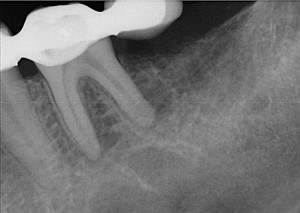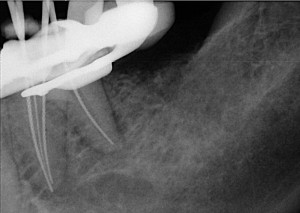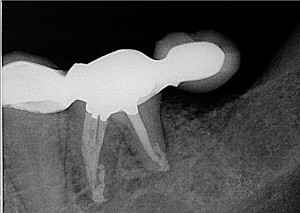The concept that multiple canals exist in a single root is not a novel idea. The mesiobuccal root of the maxillary molar is known for harboring additional canals, as is the distal root of lower molars. In fact, mandibular incisors, frequently thought of as “easy”, are known to have multiple canals as often as 40% of the time.
The mesial root of mandibular molars is fraught with danger. From concavities on the distal surface that reduce remaining dentin thickness to frequent anastomosing between the mesiobuccal and mesiolingual canals to difficulty in obtaining straight line access, this root is one to handle with care. When you consider that there is also the possibility of an additional canal in this root, treating these teeth is certainly a challenge. Use of the dental operating microscope is a great help in treating these teeth, and this is one of the reasons so much of our patient care is performed under the microscope.
According to Goel, approximately 15% of mandibular molars have a “middle” mesial canal, in addition to the mesiobuccal and mesiolingual canal. This canal often will join one of the other canals along it’s length, but may also exit separately, or may also terminate as a common apex.
The following patient presented with a very difficult situation. The patient began to notice swelling in the lower left quadrant nearly a month earlier. Because he did not have a general dentist, he was seen in a walk in clinic. On two separate occasions over a month he had taken seven days supply of antibiotics that were prescribed to him as definitive treatment. After referral to our office by a general dentist, a clinical evaluation revealed the following:
Noncontributory medical history
Afebrile
Vital signs normal
Marked extraoral swelling of left posterior mandible
Tingling and numbness of gingiva overlying #19, commissure, lip and part of chin
No periodontal pocketing greater than 4mm
Nonresponsive to Endo Ice on #19
No response to percussion or palpation on #19
Cantilever restoration #19
 Diagnosis #19: Necrotic pulp, Chronic apical abscess
Diagnosis #19: Necrotic pulp, Chronic apical abscess
Treatment plan: Nonsurgical root canal therapy, Amalgam buildup, Comprehensive treatment plan with general dentist.
At the initial visit, instrumentation was completed using copious NaOCl, a small incision and drainage was performed and calcium hydroxide was placed. At 48 hour recall the patient reported some return of sensation in the lower left quadrant and an absence of pain.
 At the second visit, two weeks after the first, the patient showed little extraoral expansion and significant return of sensation on the left hand side. The Endoactivator and PiezoFlow were both used with NaOCl for maximum disinfection. The case was obturated, restored immediately and returned to the general dentist for comprehensive care.
At the second visit, two weeks after the first, the patient showed little extraoral expansion and significant return of sensation on the left hand side. The Endoactivator and PiezoFlow were both used with NaOCl for maximum disinfection. The case was obturated, restored immediately and returned to the general dentist for comprehensive care.
 Our ultimate goal is to assist our referring doctors in any way we can. This patient had developed a severe infection, and was not in a position to start a long term oral health plan at this time. After consulting with the referring doctor, the decision was made to assist the patient in retaining his posterior mandibular function on the left side. Working as a team, this patient was able to retain function on this side and is hopefully on his way to a definitive treatment plan and improved oral health.
Our ultimate goal is to assist our referring doctors in any way we can. This patient had developed a severe infection, and was not in a position to start a long term oral health plan at this time. After consulting with the referring doctor, the decision was made to assist the patient in retaining his posterior mandibular function on the left side. Working as a team, this patient was able to retain function on this side and is hopefully on his way to a definitive treatment plan and improved oral health.
Your comments are always appreciated.